- Home
- Peripherals
- PC Gaming Speakers
These Are the Best PC Gaming Speakers Money Can Buy in 2025
Updated: September 12,2023
We gamers are a fickle lot. In our quest for the optimal gaming experience, everything has to be just right. Much like professional athletes, to be at our best while playing games, we have to have the best tools at our disposal.
Top-shelf PC specs. A comfortable chair. A great big screen gaming monitor. And yes, a killer speaker system that’ll make the neighbors wonder if some world leader has finally kicked off WW3.
Good speakers can contribute to the total immersion we rely on to get the most out of our gaming experience.
Whether it’s reveling in the delicious music of boots stomping across crushed orc bones, dreading the rat-a-tat of incoming Soviet fire, or just kicking back to some sweet tunes, the best PC gaming speakers will help transport you into a more exciting world at least for a while. Your neighbors and pets may not be as excited, but hey, you can’t please everyone, right?
Razer Nommo Pro
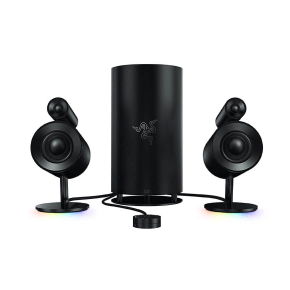
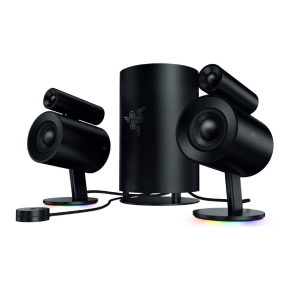
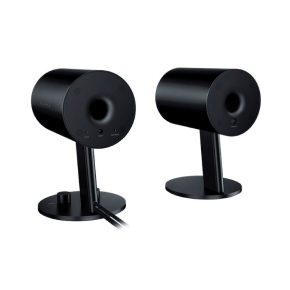
- Fantastic crisp sound
- Powerful subwoofer perfect for gaming
- THX-certified
- Very expensive
Razer is a bit like the Apple of gaming peripherals - undeniable product quality and striking aesthetics but debatable value considering the often exorbitant prices. A company that made its name on the venerable Deathadder mouse has since expanded its reach into most gaming peripherals imaginable, including excellent gaming microphones.
The Nommo Pro speakers are the company’s best gaming speakers for PC overall if you can get over the very high price.
The Nommo Pro set is a significant upgrade over the more budget-minded Nommo edition. Both satellites have gotten a makeover, and there is a very hefty and capable down-firing subwoofer. There’s also RGB, controlled through the patented Razer Chroma system.
The three-inch Kevlar fiber-coated drivers and silk-woven tweeters create a significantly better audio quality than those found on the Nommo and Nommo Chroma speakers. Razer has also gotten engineers from THX to fine-tune the already great gaming speakers, and the Dolby VSR technology does a pretty convincing job.
Considering that they are PC speakers with a subwoofer, the Nommo Pro aren’t quite on par with the best surround speakers on the market. Still, the Dolby virtual surround is definitely impressive in a high-quality gaming speaker like this, and the audio experience is not lacking.
As we’ve already said, the bass is clearly one of the most impressive parts of these Razer speakers - the rear-facing bass ports provide a sound that's punchy and has more than enough rumble to provide a room-filling sound for those intense gaming experiences we all love.
However, the sub-bass may just be a little too strong in the THX and Dolby Surround modes. Then again, these are intended for gaming and cinematic experiences. Switching to standard mode and lowering the bass are two sound adjustments you’ll want to make if you want decent sound quality from your music recordings.
One of the main reasons we’ve chosen the Razer Nommo Pro as the top computer speakers is that gaming speakers for PC need to be versatile - people want fantastic sound when gaming, but also when watching movies or listening to music.
The handy circular control pod sits on the desk and features a power button, an LED ring for volume, a headphone jack, and an auxiliary audio input. There’s also an input-switching button, which toggles among USB, optical, analog, and Bluetooth connectivity modes. Chroma software further extends the speakers’ functionality with an eight-band EQ and THX/Dolby enhancement features.
Overall, this is a phenomenal set of speakers. They offer booming bass, crisp, and clear mids and highs and have enough versatility to offer great gaming, movie, and music listening experiences. If money is no object to getting arguably the best sound setup for PC gaming, then you know what to do.
Logitech Z313



- Incredibly affordable
- Very light and compact
- Easy installation and usage
- The subwoofer is lackluster; no dedicated bass control
Much like Razer, Logitech is a household name when it comes to gaming peripherals. Unlike Razer, though, it has a long history of making computer speakers that offer impressive sound quality, so it’s little wonder that we feature as many as three of its models on our list.
If the Razer Nommo Pro speakers are the default choice for those who can afford to splash out, the Logitech Z313 speakers are a great option if you want good sound without breaking the bank.
If you’re just looking for an affordable speaker system, there are plenty of options out there. So, what makes the Z313 the best computer speakers under 50 bucks, in our opinion? Well, first of all, the two-inch drivers and four-inch subwoofer punch well above their price range.
These are a far cry from any real audiophile speakers, but considering that they cost as much as a nice steak dinner for two, you’re getting very good sound. There are no tweeters or crossovers, so it’s a good thing that the aluminum drivers are fairly small, which helps with cone break-up issues at higher frequencies.
The subwoofer, sadly, doesn’t do as well as the two speakers, and it doesn’t take much cranking for it to start distorting into a bit of a mess. But hey - these are the best budget speakers for PC gamers, not high-end devices.
It’s fine for gaming, and the boominess of the bass gives your gunshots extra oomph. Also, unlike Razer’s subwoofer, here, the majority of the sound from the sub comes from its top side, so it sounds best if positioned in such a way that you’re above it.
You can use the included remote to control the volume, but the Z313 automatically tries to balance bass and treble level and has automatic gain control, so you might want to do some fine software tuning in your EQ of choice.
In general, don’t expect miracles, but as long as you’re willing to invest a bit of time in tweaking the sound, you’ll be pleasantly surprised at what you get for under 50 bucks.
The best budget computer speakers are exactly that - the best that you can get while spending as little money as possible. While the Logitech Z313 is a good gaming sound system, don’t expect it to square off against serious competition that costs up to 10 times more money.
If you’re looking to upgrade from your monitor’s tiny built-in speakers and to get a decent starter 2.1 speaker system for very little money, you can’t beat these. Just be advised that you do need some tinkering to get the best sound out of them.
Klipsch R-51PM


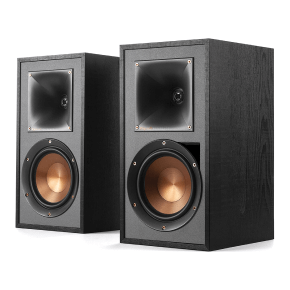
- Phenomenal sound
- Lots of power
- Wealth of connectivity options
- Expensive
While not well-known in gaming circles, Klipsch certainly has a cult following among many audiophiles. Considering this is a company that, in its long history, has almost never produced an outright bad set of speakers, we had high hopes for the R-51PM model, and it certainly didn’t disappoint.
These amazingly versatile dual speakers are not cheap, and they don’t come with gaming in mind first, but they offer a phenomenal and well-balanced sound while providing plenty of power and versatility.
Whether you’re gaming, working on your mixtape, or just enjoying some quality TV, you’ll be happy with the R-51PM’s fidelity and clarity - this is some serious sound.
The R-51PM is a successor to one of the best speakers for gaming in recent years - the excellent R-15PM, Klipsch’s widely praised active speakers featuring horn tweeters and striking copper-colored woofers.
This means you won’t need an external amplifier to get great sound quality with these speakers. The right speaker is the meat and potatoes of the setup, while the left only has a wire to connect to it.
On the right speaker, we can find a USB connection that supports up to 24bit/96 kHz. There’s also an optical input, a 3.5 mm AUX input that can be used in Line and Phono modes, a connection for hooking up a subwoofer, and an input for plugging in the passive left speaker. Although not primarily a Bluetooth speaker design, these speakers support BT wireless connectivity.
The R-15PM model was already among the best gaming PC speakers, so how have their successors improved on the formula? Well, horn tweeters are something of a Klipsch specialty, and they certainly are a bit of an acquired taste.
The good news is they sound a bit more restrained on the R-51PM while still retaining that lively character and giving the speakers a very forward-facing, live-performance-like quality. Combined with a slightly punchier bass, you get a speaker set that is very dynamic and works great for gaming.
If you were to pair these speakers with one of Klipsch’s excellent subwoofers, such as the R-100SW, you’d get a phenomenal 2.1 esports sound system that’s also fantastic for music, but such a setup won’t come cheap. Thankfully, doing so is only required if you’re a true bass aficionado, as the improved woofers on the R-51PM already do a satisfying job if you ask us.
In fact, despite the brightness of the upper mids and highs, the forward-facing nature of the R-51PMs and the lovely detailed bass make exploding demons in 2016’s phenomenal Doom reboot just as joyous as listening to a variety of music genres, from crushing death metal riffs to smooth jazz.
It can easily go toe to toe with the best PC speakers for gaming, which is fantastic for speakers that weren’t even aimed at gamers in the first place.
Overall, these are absolutely amazing speakers. They don’t come cheap, nor are they primarily aimed at gamers. But the mix of convenience, versatility, and amazing sound quality make these Klipsch speakers an easy recommendation if you’re looking for a set of universal multimedia speakers that offer a great all-around desktop sound.
Kanto YU2
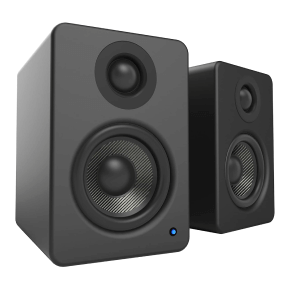
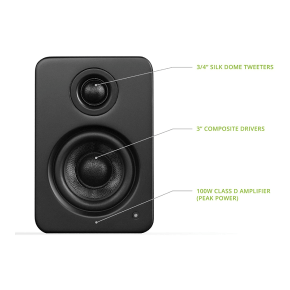
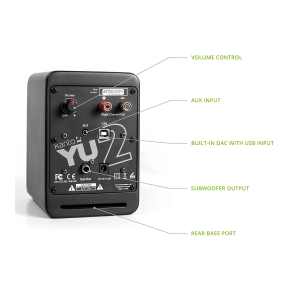
- Amazing value
- Tiny footprint on your desk
- Clear sound even when cranked
- No wireless or wall-mounting option
Logitech and Razer are well-established brands in gaming, while Klipsch is a household name behind some of the best gaming speakers on PC. Canadian-based Kanto Audio is neither, really.
Nevertheless, the Canadian company formed back in 2007 has had a solid track record of affordable active and passive speakers that feature a very neutral and clean sound at an affordable price.
The YU series continues that tradition, and the YU2 represents the smallest and most affordable model in the series. It is a bit of an Audioengine A2+ alternative (a model we also cover in this review lineup), but it comes in slightly cheaper while not offering quite the same audio fidelity.
The YU2’s small size and balanced sound for such a small package are the features that landed them on this list. The YU2 are a pair of powered stereo speakers. This means that, much like the A2 and the Klipsch R-51PM, all you need is to hook the passive speaker to the active one and then connect the latter to a source.
The internal DAC supports 16 bit/44 kHz, which, while not as impressive as the Klipsch model, will do just fine in a pinch, provided you aren’t looking for audiophile quality, in which case you’ll likely have a dedicated sound card, anyway. They also come with a wealth of connectivity options.
Despite all the perks, some compromises also had to be made due to the sub-$250 price point. These are wired speakers, and there are no Bluetooth or optical connections available, but it does feature a USB connection and a 3.5 mm AUX port. If you’re looking for cheap wireless speakers for your PC, you’ll have to look elsewhere, though.
Now let’s talk about the most important feature - the sound. Looking at the tiny 3/4-inch silk dome Tweeters and 3-inch composite drivers don’t inspire much confidence in a full and rich sound, but boy, would you be surprised.
Sure, these are designed for adding a subwoofer if you want a sound boost with no compromises, but the remarkably clear mids and highs stay distortion-free even when cranking the speakers way up.
Gunshot sounds, drum hi-hats and snares, and sword clangs all sound remarkably clear, if perhaps not as detailed as on a much more expensive set of speakers. Stereo separation is also fantastic, and the speakers really do sound a lot bigger than they really are.
In conclusion, what we have here are really good computer speakers in a remarkably small and easy-to-set-up package. If you need more power, there is always the pricier and bigger YU4 or YU6 or something from Audioengine or Klipsch.
However, unless you need to fill up a large apartment, these little guys will do the job just fine while saving you both money and desk real estate. They are also ideal laptop speakers if you want a serious sound upgrade in a tiny package that won’t break the bank.
Logitech Z906

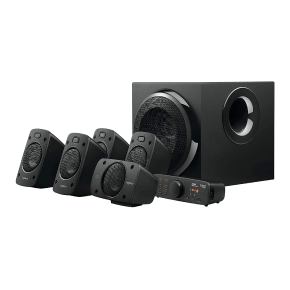

- Phenomenal gaming experience
- Easy to set up and use
- THX-certified Dolby Digital surround
- No tweeters and no Bluetooth/HDMI connectivity
It’s no coincidence that our Top 10 list features three models from Logitech. The Switzerland-based manufacturer of computer peripherals has been around since the 1980s, and Logitech speakers have always been very popular with gamers. So how does the company’s 5.1 product stack up to the competition? Let’s find out.
To start with, let’s get one thing out of the way first - these are very powerful and very loud THX-certified speakers. With 500 W of total continuous power and a staggering 1,000 W max peak power, these are probably the loudest computer speakers on our list.
The build quality is also excellent, and the sturdy speaker casings are up there with the best gaming speaker models on the market.
We don’t try actual physical violence when we test computer speakers, but we’re pretty sure these could survive a few drops or bumps, which is always a welcome feature in gaming sound systems.
There’s also a wealth of connections on the chunky subwoofer: digital, optical, and coaxial inputs, a six-channel RCA direct input, a 3.5 mm input, and finally, an input for analog stereo.
Unfortunately, the speakers don’t support Bluetooth and have no audio decoding or HDMI inputs, so their potential as a universal 5.1 speaker system is somewhat diminished. These were conceived and advertised as computer surround sound speakers, though, so it’s not all that surprising.
These specs are nice on paper, but what makes the Z906 so good? The sound, of course. These are gaming and not audiophile computer speakers. The satellites feature drivers, but no tweeters, for example. Therefore, purists looking for the ultimate sound accuracy when listening to their vinyl collection should stay away (and perhaps consider the Klipsch R-51PMs).
However, those looking for potent and punchy bass are going to love the Z906. In our tests, the bass didn’t distort even at room-shaking levels.
In fact, whether we put them through the battlefields of Somme and Stalingrad in Battlefield and CoD or got them to deal with the more nuanced soundscapes of something like Bioshock Infinite, the Z906 consistently impressed with a powerful sound that didn’t distort even at very high volumes.
Considering their price, these are definitely not the best budget PC speakers, but you get what you pay for here - for gaming purposes, the Z906 is a monster. Yes, it’s sometimes a little bass (and sub-bass) heavy, but that really is the point with these kinds of speakers, and it definitely adds a new dimension to gaming, at the expense of a little bit of music listening fidelity.
The mighty bass and satellite drivers offer a powerful and rich sound that doesn’t distort even at high volumes, but the lack of tweeters hurts the Z906 when it comes to listening to music.
Audioengine A2+

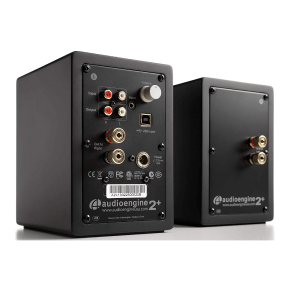
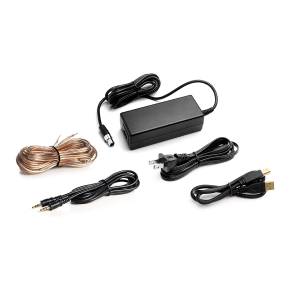
- Lovely sound for the size
- Incredibly portable
- Well-designed
- Mids are a bit harsh sometimes
Audioengine is a relatively new name on the market but did manage to produce one of the best cheap computer speakers. Founded in Austin, Texas, in 2005, the company has quickly risen to popularity in the audiophile market thanks to its excellent selection of great-sounding and affordable speakers.
This is not quite one of the top speaker brands yet, but Audioengine is definitely making waves. The excellent A5+ and its smaller brother, the A2+, played a big part in that.
If you’re looking for extremely portable computer speakers, the A2s definitely fit the bill. These speakers come with a built-in 24-bit DAC, ferrofluid-cooled silk dome tweeters, and aramid fiber-woven glass composite drivers. There are no woofers, but the quality of the tweeters and drivers matches those found on the top PC gaming speakers costing up to $500.
The setup is pretty standard for active dual speakers - the left one houses the internal amp and all of the connections (these include an RCA input and output, a mini USB digital connection, and a 3.5 mm jack for plugging in a headset). The right speaker is passive and plugs into the left one through a wire connection.
One strange design decision was putting the volume knob on the back of the active speaker, which makes volume control a bit more of a hassle than it needs to be.
Now, let’s talk about the most important part of this review - the sound. When it comes to gaming, these are some of the best computer speakers you can find in such a diminutive package.
The first thing that’ll hit you is just how well-defined and powerful the overall sound is for such tiny speakers. It also doesn’t distort at higher volumes, which is down to fantastic engineering on Audioengine’s part.
Clearly, if you’re looking for beastly bass (and especially sub-bass), you should plug these into a dedicated subwoofer, but even if you don’t, these deceptively small speakers do a completely satisfactory job. There’s also excellent stereo separation. If there’s one issue worth mentioning, it’s that the mids can sometimes get a little bit harsh in the mid-range.
Overall, these are among the best PC gaming speakers if you’re looking to save on desk real estate or get an amazing-sounding stereo setup out of very small bookshelf speakers.
Yes, there are better-sounding options out there, and yes, more affordable options, too, but if you’re looking for the ultimate set of portable and powerful stereo bookshelf speakers, you’ll be hard-pressed to do better than the Audioengine A2+.
Creative Labs Sound BlasterX Katana
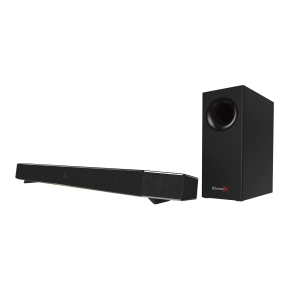


- Fantastic sound
- Striking design
- Understated but tasteful RGB lighting
- Massive wired subwoofer, bass could be clearer
Although its popularity dropped somewhat in the last decade, Creative Labs is still a household name when it comes to computer speakers. The Singapore-based company and its US subsidiary Creative Labs have been a leader in the sound card market for almost three decades and have since branched out into speakers, earbuds, and headsets.
The BlasterX is the brand’s gaming-focused set of gear that includes sound cards, headsets, keyboards, mice, and the RGB soundbar that we’re looking at today.
The Katana might be one of the best gaming soundbar options on the market, but it’s definitely not subtle. While the RGB is fairly subdued and can be turned off at will, the giant subwoofer and aggressive soundbar scream, “look at me.” While most parts are made of plastic (the soundbar does have some brushed aluminum), they are well-engineered and sturdily built.
There are also plenty of connections available, including mic and headphone connections, optical and auxiliary inputs, a Bluetooth connection, a standard-sized USB for flash drives, and finally, a micro USB audio input.
This was further improved on the Creative Sound Blaster Katana V2, which improved updated the Bluetooth support to version 5.0 and replaced the USB-C connection with USB-A. Regardless of the version, Creative made one loud soundbar with its Katana series. Cranking the volume to even around a third of its maximum value results in a crushingly loud but still very clear sound.
It’s important to note that while the soundbar itself is fairly compact, a lot of quality gear is packed into it. There are two 1.3-inch tweeters and two Neodymium-powered drivers for plenty of detail in the mid-bass and upper regions, while the chunky subwoofer handles the frequencies between 20 and 150 Hz.
This offers plenty of booming bass that is both heard and felt as soon as you crank things up a bit. While these are definitely some of the best subwoofer speakers within the domain of soundbar systems, they do sometimes sound a little bit blunt, and the bass can get muddy in some cases. That said, you can’t expect super high-quality audio from a mid-range soundbar.
Another feature enhancing the sound is the presence of a very capable 24-bit/96 Hz DAC for lossless playback of your favorite hi-res audio files. Remember, it’s Creative we’re talking about here. You’re not just getting a soundbar with a subwoofer; you’re getting a complete audio system with a very capable sound card.
Overall, the striking looks, wealth of connection options, and great gaming experience make up for the slightly blunt-sounding bass and the overly large subwoofer. If you’re looking for a serious soundbar for PC gaming, Creative has you covered. Just be advised that the best computer speaker doesn’t necessarily come cheap.
Audioengine HD3 Wireless

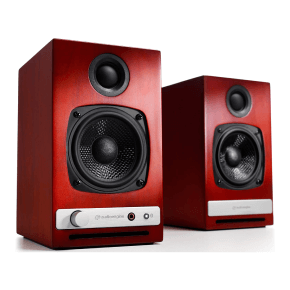

- Lovely sound
- Excellent imaging
- Stylish and versatile
- Bass could be better
Aside from Logitech, Audioengine is the only brand we’re featuring more than once in this review roundup. The reason is rather simple - these folks are synonymous with audio quality. The HD3 Wireless is Audioengine’s Bluetooth take on the amazing HD3 speakers.
The HD3s are the successors to the fantastic A2+, while their bigger cousin - the HD6 - was designed as a follow-up on the A5+ model. The HD3 wireless is an absolutely fantastic speaker, but does it do enough to justify a significant price jump from one of the top computer speakers made by Audioengine? Let’s find out.
First, let’s talk specs. At seven inches tall and four inches wide, these are slightly bigger and also heavier than the A2 but still very portable. The design is also much more appealing, with cherry or walnut wood veneer finishes, as well as the more traditional satin black and high gloss white options.
There’s also an aluminum strip at the bottom of the front side of both speakers, housing a Bluetooth pairing button, a headphone jack, and a volume knob on the left active speaker. As we’ve already said, at well over 300 bucks, these couldn’t be classified as the best budget PC gaming speakers around, but the build quality justifies their higher price tag.
Both speakers have silk dome tweeters and Kevlar woofers, and the left one is active, housing a 24-bit DAC as well as all of the connections: USB, Bluetooth, 3.5 mm, and RCA, which also allows you to plug in a subwoofer. If you’re using a typical built-in sound card, you’ll want the audio through the mini USB port, as it bypasses your PC’s internal audio hardware.
Speaking of which, let’s get to the most important part of this review - the sound. Audioengine has done something rather special here. If we put the HD3 up against the best floor-standing speakers on the market, they’ll come up short in some areas.
But let’s be real here - in this size category, for speakers meant as desktop replacements, you’d be very hard-pressed to do better, even while paying significantly more money. Make no mistake: if you’re upgrading from even the best built-in laptop speakers on the market, it’s a night-and-day difference in the overall audio experience.
The mids are lovely and rich, the stereo separation and near-field imaging are excellent, and the treble is poignant while not sounding shrill. If we were to criticize one thing, it would be the typical limitations of speakers of this size: the lower frequencies.
We’ve already said it - these are some of the best USB speakers you can get in this size format, but that portability does come with its drawbacks. If you want punchy, strong bass (and sub-bass) for your gaming setup or music, fork up the extra cash for that subwoofer - there’s only so much that 65+ Hz can do in this department.
Overall, though, if you don’t mind paying the premium, these are some of the greatest-sounding small speakers you’ll ever find. The excellent wireless implementation is just the icing on the cake.
Steljes Audio NS3

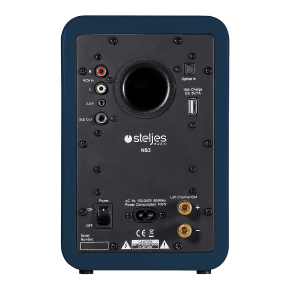
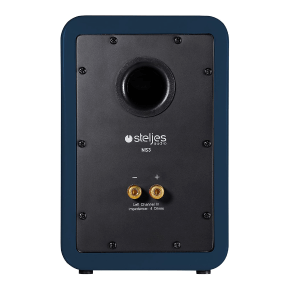
- Excellent sound for the price
- Fantastic build and design
- Lots of connectivity options
- USB charging but no audio input
While most gamers and audiophiles will recognize the likes of Logitech, Razer, Sound Blaster, Klipsch, or Audioengine, brands like Steljes Audio are less well-known but not any less worth your time or money.
The UK-based company has been around since 2002 and has generally been making well-received speakers and amplifiers but failing to capture a larger market share due to the well-established competition.
The NS3 is a fun, well-designed speaker set with plenty of connectivity options that offers great value as a Bluetooth stereo set and truly opens up when paired with an appropriate subwoofer.
The best wireless speakers come with a wealth of connection options, and the NS3 mostly delivers here. If you can get over the fact that the USB connection is for charging only, the rest is excellent. As is standard for a powered set of speakers, a class D amp and all of the connections are located on the active speaker, while the passive one connects directly to it.
There is an RCA connection and subwoofer input, a 3.5 mm jack, and an optical input. Finally, you get a dedicated Bluetooth pairing button with the included remote, which is a great addition. The design is also very stylish, with a choice of eight colors, including the very British-looking vermillion red. They might not be the best PC speakers on the market, but they certainly look good.
So, they look great, and they have a wealth of connection options, but what about the most important thing - the sound? In short, it’s very good.
The one-inch soft dome tweeters and four-inch woven fiberglass drivers produce a very even and clean sound, with pleasant treble and a surprisingly capable and earthy bass. Vocals on this speaker for a computer are pretty impressive and instrument separation is done professionally, as well.
Whether you’re listening to electronica, metal, or cranking up a first-person shooter, the tonal variety of the NS3 continually makes a good impression. Obviously, there are some limitations for speakers of this size - if you’re looking for bone-crunching sub-bass, you should invest in a proper subwoofer.
At around £200, the NS3 aren’t exactly the best budget speakers for PC gaming, but you really are getting your money’s worth here. The stylish design, crisp and clean sound, and excellent wireless Bluetooth performance all make these an easy recommendation if you need a solid set of USB-powered speakers. It’s just a shame that the USB port is suitable for charging only.
Logitech G560
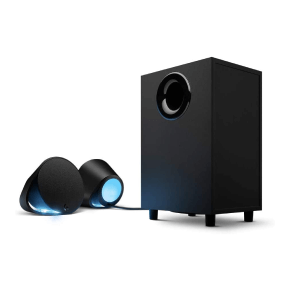
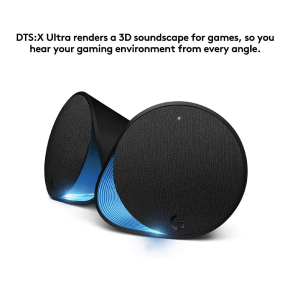

- Powerful sound
- Built-in virtual surround sound
- Screen sampling RGB lighting is cool...
- ...but it could’ve been implemented better
Whether you’re looking for a 2.1, 5.1, wireless, or USB speaker set, Logitech has you covered. After already claiming the top budget and surround sound spots, the third showing from Logitech is a fantastic 2.1 set of RGB speakers that not only sound good but also have great aesthetics, and unique lighting features worth praising. But let’s start with the basics.
The G560 is a powerful 120 W RMS 2.1 set, including two RGB satellites and a chunky subwoofer that doubles as a footrest. The speakers themselves aren’t exactly subtle, either, being six or so inches tall. Good PC speakers need to have some heft, though, and unless you really have limited desk space, the G560’s size probably won’t be a problem.
The controls are all located on the right satellite speaker - there is a volume knob and an RGB brightness button on the front, while at the back, you can find a Bluetooth pairing button and one for turning off the speakers. In terms of connections, these aren’t the best speakers for gaming, but they do have the basics covered. You have the wireless option with Bluetooth connectivity, a USB computer connection, and a 3.5 mm headphone jack.
Before moving on to sound, let’s talk about the main selling point of this speaker set: the lighting. While many gaming peripherals these days feature RGB lighting, Logitech has tried something new here, and for the most part, it pays off.
The idea behind the screen sampler is that it takes note of what’s happening in the corners of your screen and tries to adjust the lighting to match it. Basically, it’s a rudimentary version of Ambilight systems you can find on Phillips screens or as third-party kits for your monitor.
While the system can be a bit aggressive and certainly needs more fine-tuning, these are still the best USB speakers when it comes to RGB lighting. Just be aware that you need to run your games in Borderless Window to take full advantage of the screen sampling feature.
Now, let’s talk about the sound. For gaming-focused 2.1 speakers, Logitech has done rather well here. The bass is powerful and booming without distorting too much, even at higher volumes, while the midrange is comfortably warm.
There is also a very capable built-in virtual surround, courtesy of Dolby’s competitor DTS, and if you space out your satellites, it can give a fairly convincing simulation of true surround. Then again, if more than 2.1 is what you’re after, the Z906 probably remains the best surround speaker option from Logitech.
Overall, this is a fantastic set of speakers. There are cheaper, better-sounding, and certainly more compact options out there, but the mix of great sound and cool RGB lighting effects make it an easy recommendation for anyone looking to take their gaming experience to the next level.
Top 5 Best Gaming Speakers for PC in 2025
- Razer Nommo Pro
- Klipsch R-51PM
- Kanto YU2
- Logitech Z906
- Sound BlasterX Katana
Our Methodology for Finding the Best PC Gaming Speakers
Speaker Type
The first thing we look at when choosing computer speakers is the format. Standard stereo speakers are somewhat of a rarity in gaming since gamers usually like the bass that subwoofers provide. But 2.1 is basically just a stereo with the highs and mids assigned to satellites while the sub takes care of the bass.
If you want a true surround sound experience, you may want to go for 5.1 or even 7.1 computer speakers - the same concept as 2.1, just with more satellites. Then, there are bookshelf speakers and soundbars if you’re really limited with space, and Bluetooth wireless speakers if you want an easily portable solution or just hate cables.
Another important consideration when choosing the best speakers for PC gaming is how powerful it is and what sorts of connection options come with them. Unlike wireless speakers built for the great outdoors, PC speakers need a little bit more juice.
Those with a higher wattage will generally output more power, which will be needed if you want to game in a large open space or just like to crank things up without losing audio fidelity. Speakers with no internal amps or power sources will need to be plugged into your computer and sound card.
Most people also need a headphone jack in order to switch to their headsets easily. There’s also the matter of USB vs. traditional inputs such as analog and optical. The former provides much easier installation and requires no extra hardware.
On the flip side, analog and optical inputs are often found on the best desktop speakers and audiophile speakers and generally provide superior sound quality overall.
Sound quality is a debatable subject - not everyone likes the same things, and it can sometimes be hard to quantify great sound. The quality itself can sometimes be hard to quantify, but unless you’re looking for Bluetooth speakers on a tight budget, this is the most important factor to consider.
Nevertheless, in this section, we look at various objective PC gaming speakers benchmarks, such as the frequency response that the speakers can produce.
The typical cited human hearing range is from 20 Hz to 20 kHz, but in practice, we don’t so much “hear” the low bass frequencies as feel them with our bodies, while the higher-pitched frequencies become harder to distinguish as we get older. People looking for the best computer speakers for music also consider factors such as sensitivity and sound pressure level and impedance (how hard the amp is being pushed by the speakers).
The thing listeners want most often is an overall balanced sound. So, when listening, they’ll work out whether certain frequencies are overly accentuated or underrepresented. Another aspect is how natural voices, instruments, SFX, and environmental noises sound. Finally, if the speakers provide 3D and surround sound, how convincing and immersive is it?
This category is arguably less important than the sound quality, but certainly one you should not ignore. Speaker housing and drivers can be made from a variety of materials, but what you’re looking for are durability and craftsmanship.
Top gaming speakers tend to use cheaper materials than audiophile models, primarily due to price concerns. Still, it’s important to be able to spot shoddy craftsmanship, a bad wiring job, or other similar factors that’ll negatively impact the life expectancy of your speakers.
Lastly, although the design isn’t as important as durability in this context, you should still be able to find a nice-looking speaker to sit on top of your fancy gamer desk.
The price of desktop speakers varies from dirt-cheap models that’ll set you back as much as a lunch in a decent diner to audiophile-grade speakers that cost more than your entire gaming setup. The key idea here is finding the best budget PC gaming speakers that offer the biggest bang for your buck, considering your particular needs and budget.
Frequently Asked Questions
FAQ
Yes. It’s certainly not mandatory, but a lot of games are made with surround sound in mind. In addition to giving you a competitive advantage online, surround sound can definitely make you feel more immersed in gaming.
Most do, but if you’re serious about gaming, you should look at getting external speakers. Even the best monitor-based ones can’t really compare to most entry-level dedicated computer speaker systems, and the best computer speakers under 100 bucks thrash them in the performance department.
Yes, having a USB connection has become the standard for PC speakers and audio interface connections these days. While some audiophiles still prefer analog connections, even high-end speakers from the likes of Klipsch and Audioengine happily project fantastic soundscapes through a digital USB connection.
For gaming, probably. A good subwoofer doesn’t just provide a more powerful and articulate bass response, but you can really feel that sub-bass thump in your gut, which is a fantastic feeling when gaming.
Some are. To be perfectly honest, the best PC gaming speakers are never going to be soundbars. That said, models such as the Sound BlasterX Katana show us that a well-designed soundbar can almost match the quality of a dedicated 5.1 surround system while taking up far less space. So if you’re looking for a fairly potent and portable alternative that saves on desk space, soundbars are definitely a great option for gaming.
Your email address will not be published.
![$row['title'] - image](https://trinity-core-s3.s3.us-west-1.amazonaws.com/kommandotech/674/Razer-Nommo-Pro-1.png)
![$row['title'] - image](https://trinity-core-s3.s3.us-west-1.amazonaws.com/kommandotech/675/Logitech-Z313-1.png)
![$row['title'] - image](https://trinity-core-s3.s3.us-west-1.amazonaws.com/kommandotech/676/Klipsch-R-51PM-1.png)
![$row['title'] - image](https://trinity-core-s3.s3.us-west-1.amazonaws.com/kommandotech/681/Kanto-YU2-1-1.png)
![$row['title'] - image](https://trinity-core-s3.s3.us-west-1.amazonaws.com/kommandotech/682/Logitech-Z906-1.png)
![$row['title'] - image](https://trinity-core-s3.s3.us-west-1.amazonaws.com/kommandotech/683/Audioengine-A2%2B-1.png)
![$row['title'] - image](https://trinity-core-s3.s3.us-west-1.amazonaws.com/kommandotech/684/Creative-Labs-Sound-BlasterX-Katana-1.png)
![$row['title'] - image](https://trinity-core-s3.s3.us-west-1.amazonaws.com/kommandotech/685/Audioengine-HD3-Wireless-1.png)
![$row['title'] - image](https://trinity-core-s3.s3.us-west-1.amazonaws.com/kommandotech/694/Steljes-Audio-NS3-1.png)
![$row['title'] - image](https://trinity-core-s3.s3.us-west-1.amazonaws.com/kommandotech/696/Logitech-G560-1.png)